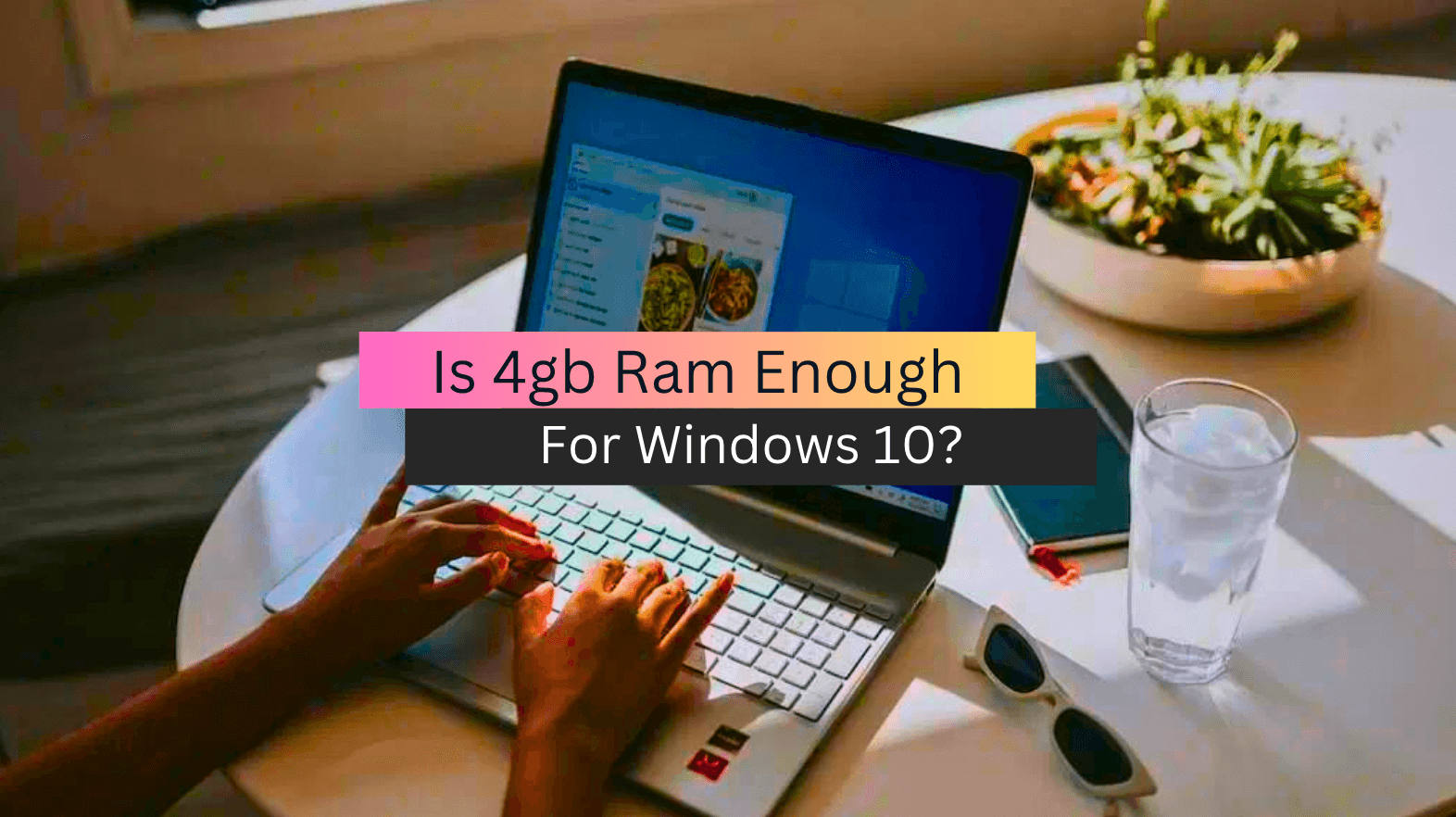Is 4gb Ram Enough For Windows 10?
Are you considering upgrading your computer’s RAM and wondering if 4GB is enough for running Windows 10? Well, the answer is not as straightforward as a simple “yes” or “no.” While 4GB of RAM may have been enough for earlier versions of Windows, such as Windows 7 or 8, Windows 10 is a more resource-intensive operating system. It is designed to run on a minimum of 4GB of RAM, but that doesn’t necessarily mean it will run smoothly.
To determine if 4GB of RAM is enough for Windows 10, we need to dive deeper into the various factors that affect system performance, including the user’s specific needs and usage patterns. So, let’s explore this topic further and help you make an informed decision about how much RAM you need for Windows 10. You may also read Best Laptop for Investment Banking
Is 4 GB Ram Enough For Windows 10?
Yes, 4GB of RAM is technically enough to run Windows 10, but it may not provide an optimal experience for the user, especially if you run multiple applications at once or perform memory-intensive tasks like gaming or video editing.
Windows 10 requires a minimum of 2GB of RAM to operate, and while 4GB meets this requirement, it leaves little room for other processes to run smoothly. With only 4GB of RAM, you may experience slowdowns, lag, and other performance issues when running multiple applications simultaneously or when performing memory-intensive tasks.
Furthermore, as software and applications continue to become more advanced and resource-intensive, having 4GB of RAM may not be sufficient for future-proofing your device. If you’re considering purchasing a new computer or upgrading an older one, it’s generally recommended to opt for a device with at least 8GB of RAM, especially if you’re planning on using it for work or demanding tasks like gaming or video editing. You may also read the expert guide on the Best Laptop For Construction Management
How Much RAM Does Windows 10 Need To Run Smoothly?
The amount of RAM required for Windows 10 to run smoothly largely depends on the tasks and applications being used. Microsoft recommends at least 4GB of RAM for the 64-bit version of Windows 10, but 8GB or more is recommended for a better experience, especially for power users who run multiple applications simultaneously.
If you plan to use resource-intensive applications such as video editing software, graphic design software, or virtual machines, it is recommended to have at least 16GB of RAM. Having more RAM can also improve the performance of your computer by allowing it to store more data in memory and reducing the need for slower hard disk access.
Is 4GB RAM With SSD Enough For Windows 10?
Yes, 4GB RAM with an SSD is enough for running Windows 10. However, the performance may not be optimal for heavy multitasking or running resource-intensive programs.
Windows 10 requires a minimum of 2GB of RAM to function properly, and 4GB RAM is recommended for optimal performance. The addition of an SSD will also greatly improve the system’s overall speed and responsiveness, as SSDs are significantly faster than traditional hard drives.
With 4GB of RAM, Windows 10 should be able to run the most basic programs and perform day-to-day tasks such as web browsing, email, and word processing without any issues. However, running multiple applications simultaneously or running more demanding programs such as photo or video editing software may result in slower performance.
If you plan on using your computer for more demanding tasks, it may be worth considering upgrading your RAM to 8GB or more. This will help to ensure smooth performance and reduce the likelihood of experiencing slowdowns or crashes. You may read also How To Project Laptop Screen To Wall Without Projector
Which Windows 10 Is Best For 4GB RAM?
Windows 10 is a versatile operating system that offers various versions suitable for different hardware configurations. If you have a computer with 4GB of RAM, you can run any version of Windows 10, but some editions may perform better than others.
The most suitable Windows 10 edition for a computer with 4GB of RAM is Windows 10 Home or Windows 10 Pro. These versions are designed for home users and small businesses and come with all the essential features needed for daily computing tasks.
Windows 10 Home and Pro editions require a minimum of 2GB of RAM, which means that a computer with 4GB of RAM should have no issues running these versions. However, to ensure optimal performance, it is recommended to close unnecessary applications and processes while running resource-intensive programs.
It is worth noting that Windows 10 Home and Pro editions support a maximum of 128GB of RAM, which means that if you plan to upgrade your RAM in the future, you may need to consider other versions such as Windows 10 Enterprise or Windows 10 Education. You may read the expert guide on the best laptops for financial modeling
Is 4 GB Ram Enough For a PC?
4GB of RAM is generally not enough for a modern PC to operate smoothly, especially if you plan on running multiple applications simultaneously or using memory-intensive programs such as video editing software, graphic design tools, or video games.
Most operating systems, including Windows and macOS, recommend at least 8GB of RAM for optimal performance. This is because the more RAM your computer has, the more programs and data it can store in the memory for quick access.
With 4GB of RAM, your computer may struggle to handle basic tasks such as web browsing, word processing, or watching videos, especially if you have multiple tabs or windows open at the same time. You may experience slow performance, freezing, or crashes.
Furthermore, some newer applications and games require even more than 8GB of RAM to function properly. If you plan on upgrading your computer, it’s recommended to invest in at least 16GB of RAM to future-proof your system and ensure it can handle any demanding tasks or applications you might encounter.
Overall, 4GB of RAM may be enough for a basic computer or for light use, but for most users, it’s best to aim for at least 8GB or more to ensure a smooth and efficient computing experience.
Conclusion
In general, 4GB of RAM can run Windows 10, but it may not provide the best user experience. While the minimum requirements for Windows 10 are 1GB for the 32-bit version and 2GB for the 64-bit version, running the operating system with only 4GB of RAM may result in slower performance, longer boot times, and a reduced ability to multitask. If you plan on using your computer for basic tasks such as browsing the internet and using Microsoft Office, 4GB of RAM may suffice. However, if you plan on using more demanding software, such as video editing or gaming, upgrading to at least 8GB or 16GB of RAM is recommended for optimal performance. You may check also Best Laptop for DevOps Engineers
FAQs
Is Windows 10 64-bit good with 4GB RAM?
Windows 10 64-bit can technically run on a system with 4GB RAM, but it may not perform optimally. 4GB RAM may not be enough for modern applications and multitasking, resulting in slower performance and occasional freezes. Upgrading to 8GB or more RAM would improve the system’s performance.
How much RAM does Windows 10 need to run smoothly?
Microsoft recommends a minimum of 4 GB of RAM for a smooth experience running Windows 10. However, for more demanding tasks such as video editing or gaming, 8 GB or more of RAM may be necessary. The amount of RAM required also depends on the specific hardware and software being used. You may read the ultimate guide on the Best Laptop for Matlab
Is 4GB better than 8GB Windows 10?
No, 8GB of RAM is better than 4GB for running Windows 10. While it is possible to run Windows 10 with 4GB of RAM, it may cause the system to run slower and struggle with running multiple applications simultaneously. 8GB of RAM provides better performance and allows for smoother multitasking.
Is a laptop with 4GB RAM enough?
It depends on your usage requirements. For basic tasks like web browsing, email, and document editing, 4GB RAM can be sufficient. However, if you plan to run multiple applications simultaneously, work with large files, or use memory-intensive software, then you may need more than 4GB RAM for optimal performance.







